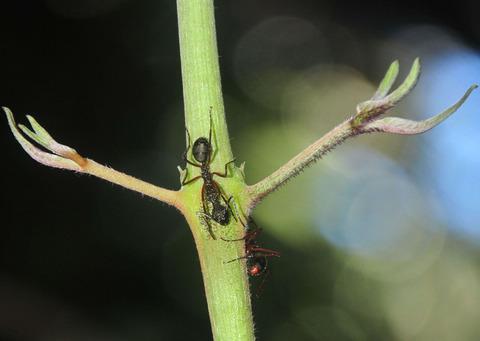Our official English website, www.x-mol.net, welcomes your
feedback! (Note: you will need to create a separate account there.)
Variation in the production of plant tissues bearing extrafloral nectaries explains temporal patterns of ant attendance in Amazonian understorey plants
Journal of Ecology ( IF 5.3 ) Pub Date : 2019-12-18 , DOI: 10.1111/1365-2745.13340 Anselmo Nogueira 1 , Fabricio B. Baccaro 2 , Laura C. Leal 3 , Pedro J. Rey 4 , Lúcia G. Lohmann 5 , Judith L. Bronstein 6
中文翻译:

带有花外蜜腺的植物组织产量的变化解释了亚马逊底层植物的蚂蚁出勤时间模式
更新日期:2019-12-18
Journal of Ecology ( IF 5.3 ) Pub Date : 2019-12-18 , DOI: 10.1111/1365-2745.13340 Anselmo Nogueira 1 , Fabricio B. Baccaro 2 , Laura C. Leal 3 , Pedro J. Rey 4 , Lúcia G. Lohmann 5 , Judith L. Bronstein 6
Affiliation

|
- Information on direct and indirect drivers of temporal variation in ant–plant interactions is scarce, compromising our ability to predict the functioning of these ecologically important interactions.
- We investigated the roles of precipitation, ant activity, abundance of young plant tissues bearing extrafloral nectaries (EFNs) and EFN phenotypes in the establishment of EFN‐mediated ant–plant interactions throughout the year in Amazonia, Brazil. We hypothesized that the frequency of ant–plant interactions follows a predictable seasonal pattern, being higher in wetter periods, during which plants invest more in the production of new plant tissues bearing EFNs, ultimately promoting ant attendance. We surveyed and tagged every understorey Bignonieae plant rooted inside 28,500‐m2 plots, and recorded ant–EFN interactions on each plant five times throughout the year. We also sampled ants with honey baits to estimate temporal variation in general ant activity.
- Contrary to our hypothesis, the proportion of plants tended by ants in each plot was higher in drier, not wetter, months. Ant attendance was indirectly and negatively related to precipitation, which was attributed to a decrease in the proportion of plants producing new EFN‐bearing plant tissues during the wetter period. Additionally, seasonal variation in an ant activity did not explain temporal patterns of plant attendance. At the plant level, ant attendance increased strongly with the number of recently formed shoot nodes, and ants almost never attended plants with limited or no young tissue. Among the 12 most abundant Bignonieae species, the amount of young tissue was the most important predictor of ant attendance, secondarily explained by the EFN secretory area.
- Synthesis . Our results suggest that seasonal variation in the production of new plant tissues bearing EFNs is the primary driver of the temporal patterns of EFN–plant attendance by ants in this system. Contrary to our expectations, production of new plant tissue is higher in the drier months of the year, which in turn boosts the frequency of interactions between ants and EFN‐bearing plants in the dry season. These results highlight the role of plant phenology in the remarkable variation encountered in ant visitation to EFN‐bearing plants in both space and time.
中文翻译:

带有花外蜜腺的植物组织产量的变化解释了亚马逊底层植物的蚂蚁出勤时间模式
- 关于蚂蚁与植物相互作用的时间变化的直接和间接驱动因素的信息很少,这损害了我们预测这些重要生态相互作用的功能的能力。
- 我们调查了降水,蚂蚁活性,带有花外蜜腺(EFNs)和EFN表型的年轻植物组织的丰度在全年建立的由EFN介导的蚂蚁-植物相互作用中在巴西亚马逊州的作用。我们假设蚂蚁与植物的相互作用频率遵循可预测的季节性模式,在潮湿的时期会更高,在此期间,植物对具有EFN的新植物组织的生产投入了更多的资金,最终促进了蚂蚁的出勤。我们调查并标记了每棵埋藏在28,500-m 2地块内的底层植物,并在一年中五次记录了每棵植物上蚂蚁-EFN的相互作用。我们还用蜂蜜诱饵对蚂蚁进行了采样,以估计一般蚂蚁活动的时间变化。
- 与我们的假设相反,在每个地块中,蚂蚁抚养的植物比例在较干燥而不是较湿润的月份中较高。蚂蚁的出勤与降水量之间存在负相关关系,这归因于在湿润时期产生新的带有EFN的植物组织的植物比例的下降。此外,蚂蚁活动的季节性变化不能解释植物出勤的时间模式。在植物一级,随着最近形成的芽结的数量增加,蚂蚁的出勤率大大增加,而蚂蚁几乎从未参加过组织很少或没有年轻组织的植物。在12种最丰富的双子叶植物物种中,年轻组织的数量是蚂蚁出勤的最重要预测因子,其次是EFN分泌区。
- 综合。我们的结果表明,带有EFN的新植物组织生产中的季节性变化是该系统中蚂蚁EFN随时间变化的主要驱动因素。与我们的预期相反,一年中较干燥的月份中,新植物组织的产量较高,这反过来又增加了干旱季节中蚂蚁与带有EFN的植物之间相互作用的频率。这些结果突出了植物物候学在蚂蚁探视携带EFN的植物在空间和时间上遇到的显着变化中的作用。











































 京公网安备 11010802027423号
京公网安备 11010802027423号